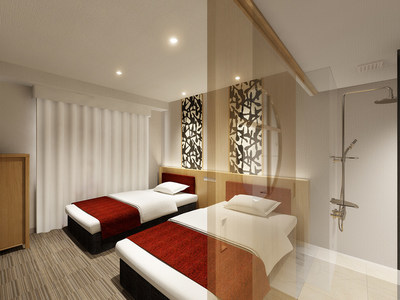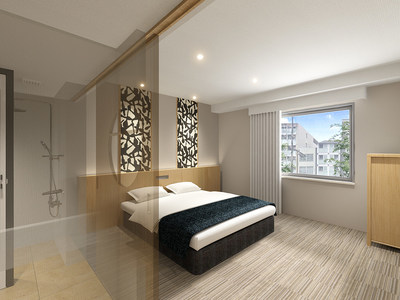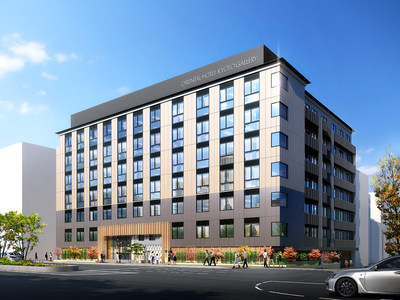Toward a Hotel Incorporating Traditional Motifs of Kyoto and Omotezashiki (Traditional Welcome Room) Design
KYOTO,Japan,May 30,2019 -- Hotel Management Japan Co.,Ltd. (head office: Shibuya Ward,Tokyo; representative director: Shunzo Azuma; hereinafter referred to as "HMJ"),a hotel management company,has announced that it will open its Oriental Hotel Kyoto Gallery on Monday,September 2,2019 in Kyoto's Kiyomizu-Gojo area. The hotel's concept is "The Essence of Kyoto." This is embodied via the combination of various traditional and stylish Kyoto motifs and by adding such essences to various areas of the hotel,allowing visitors to experience a comfortable space designed with people in mind and for the flow of hotel visitors. The hotel is located within walking distance of many historical areas of Kyoto,such as Gion,Kiyomizu Temple,and Yasaka Shrine,thus allowing visitors to enjoy Japanese art and culture along with the main attractions of the Kyoto cityscape.

Guest room
* Hotel external view
https://kyotogallery.oriental-hotels.com/(site launch tentatively planned for April 26,2019)
Scheduled date of start of business:Monday,2019
Website:https://kyotogallery.oriental-hotels.com/(site launch tentatively planned for April 26,2019)
Address:423-1 Sujakucho,Higashiyama Ward,Kyoto,Japan 605-0901
Building size:Seven floors above ground,total floor area of 4,615 m2
No. of guest rooms:150 (19 double bedrooms,128 twin bedrooms,two suites,and one room featuring universal design)
Dining facilities:One cafe (52 seats; limited to hotel guests only) (serving breakfast from 7 a.m. to 10 a.m.,then as a cafe from 10 a.m. to 11 p.m.)
Access:One minute on foot from Kiyomizu-Gojo Station on the Keihan Main Line
Opening soon: Oriental Hotel Kyoto Gallery
Hotel Details
Kyoto's traditional art and architecture
From the entrance,which welcomes guests to the lobby and to,eventually,the rooms,various Kyoto traditional motifs are incorporated along all the routes that guests walk. Visitors during their stay can experience a comfortable space designed with people in mind and for the flow of hotel visitors.
Essence of the Hotel: Main Points
Entrance
Traditional motif 1: Vertical grid design
Vertical grid design was used during the Heian Period in shrines,temples,or in the residences of noble families,incorporated into doors or developed as fixtures. This design helps aid privacy,while also allowing breeze and light to penetrate inward.
Traditional motif 2: Checkered patterns
During the middle of the Edo Period,kabuki actor Ichimatsu Sanogawa adored this pattern for clothing,causing the pattern to become favorable Japan-wide. It became preferred due to its auspiciousness,carrying the nuance of prosperity of offspring and the expansion of business,as the pattern continues uninterruptedly.
Reception/Lobby & Lounge
Traditional motif 3: Rinpa school of painting
This bold form of composition,using gold and silver foil as the background,with repeating patterns,is said to be characterized by techniques such as tarashikomi drip painting,and is a school from the art of design that was active from the late Momoyama Period up to modern times.
Traditional motif 4: Japanese doma room design
Doma,a traditional form of flooring,allows one to do outside work while still inside. As a design,the hotel incorporates the Japanese doma atmosphere,via old fixtures,colorful lights,traditional doors,and an ambience that takes the "outside" and brings it "inside."
Restaurant and café
Traditional motif 5: Wooden framing
Using wood in construction is one of the traditional techniques of Japanese architecture. This beautiful technique,which does not use hardware,can be realized by processing surface unevenness for jointing,connections,and fitting on a single piece of material,done by a carpenter in a style unique to Japan,where there is a lot of moisture and where the temperature difference can be severe.
Guest Rooms
Traditional motif 6: Yukimi shoji Japanese window/wall screening
By putting Japanese washi paper on one side of a wooden frame as per a normal shoji screen but then by making the bottom portion of the wooden frame transparent glass,it was/is possible to see,for example,how much snow could possibly have piled up outside the room,thus the word/name yukimi shoji ("shoji that allows you to see the snow") was coined.
Traditional motif 7: Suibokuga ink wash painting
Suibokugais believed to have been established in the Tang Dynasty and later introduced to Japan during the Kamakura Period. It is form of sumi-e painting that is expressed in ink (ink wash painting),not only via black ink lines,but also in ways that represent shading,lightness,and darkness,via blurring.
Waking up warmly: Soup and rice breakfast
Breakfast: The breakfast buffet carries the theme of "A meal with soup." The chef-designed soup menu that pays homage to each season incorporates three different soup types featuring casual nutrition that will warm your body. Come and enjoy your favorite soup with rice and toppings.
Cafe: The cafe/restaurant can be used as a free space for guests only during the daytime,where visitors can enjoy their favorite coffee,tea,or green tea,etc.
Operating company: HMJ International Co.,Ltd.
The Oriental Hotel Kyoto Gallery hotel is operated by HMJ International Co.,Tokyo; representative director: Allan Takahashi),as an operating company,while Hotel Management Japan,Co.,Inc. (HMJ) is responsible for the hotel's management.
Hotel Management Japan Co.,Ltd.: Company Profile
Hotel Management Japan Co.,Ltd. (HMJ) is a hotel management company that operates 18hotels in Japan with a total of 5,433rooms. HMJ operates widely in the sphere of hotel management,such as for Tokyo Disney Resort® and for partner hotels,as well as for domestic and foreign brands such as "Oriental," "Hilton," "Marriott," and "Holiday Inn" nationwide in Japan.
* Number of group hotels: 18(total number of rooms for all group hotels: 5,433; total number of employees for all group hotels: Approximately 2,400 people
* Domestic hotels: 18
Hotel Hilton Narita (Narita City,Chiba Prefecture/548 rooms),International Garden Hotel Narita (Narita City,Chiba Prefecture/463 rooms),Oriental Hotel Tokyo Bay (Urayasu City,Chiba Prefecture/511 rooms),Hilton Tokyo Odaiba (Minato Ward,Tokyo/453 rooms),Hotel Oriental Express Tokyo Kamata (Ota Ward,Tokyo/158 rooms),Hotel Oriental Express Tokyo Ginza (opening in July 2019) (Chuo Ward,Tokyo/103 rooms),Oriental Hotel Kyoto Gallery(opening in September 2019)(Higashiyama ku,Kyoto/150),Hotel Nikko Nara (Nara City,Nara Prefecture/330 rooms),Holiday Inn Osaka Namba (Chuo Ward,Osaka City/314 rooms),Namba Oriental Hotel (Chuo Ward,Osaka City/258 rooms),Hotel Oriental Express Osaka Shinsaibashi (Chuo Ward,Osaka City/124 rooms),Oriental Suites Airport Osaka Rinku (opening in December 2019) (Izumisano City,Osaka/258 rooms),Kobe Meriken Park Oriental Hotel (Chuo Ward,Kobe City/319 rooms),Sheraton Grand Hotel Hiroshima (Higashi Ward,Hiroshima City/238 rooms),Oriental Hotel Hiroshima (Naka Ward,Hiroshima City/227 rooms),Oriental Hotel Fukuoka Hakata Station (Hakata Ward,Fukuoka City/221 rooms),Hotel Nikko Alivila (Yomitan Village,Okinawa Prefecture/397 rooms),Okinawa Marriott Resort & Spa (Nago City,Okinawa Prefecture/361 rooms)

Guest room

Lobby

Hotel Entrance

View original content to download multimedia:/news-releases/toward-a-hotel-incorporating-traditional-motifs-of-kyoto-and-omotezashiki-traditional-welcome-room-design-300858836.html